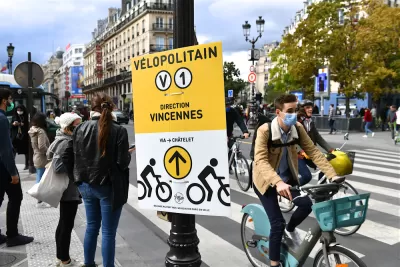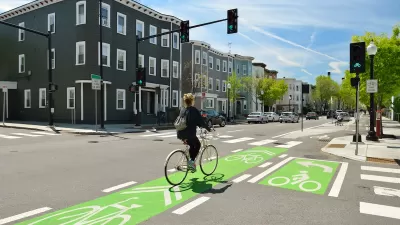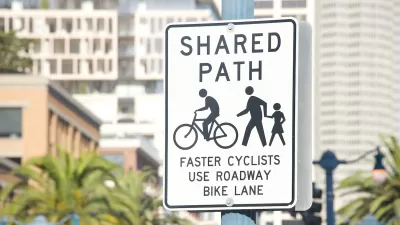While some cities are reverting back to pre-pandemic street configurations, others are taking advantage of the momentum for bike and pedestrian infrastructure to make pandemic-era projects permanent.

Writing in Momentum Magazine, Ron Johnson highlights three cities where pandemic-era bike infrastructure projects have become permanent.
In Toronto, Yonge Street, a busy north-south corridor, received separated bike lanes. “After 18 months of installation, the data demonstrates increases (ranging between 57 percent and 250 percent) in cycling trips and increases in pedestrian trips (ranging between 59 percent and 145 percent) on the corridor, as well as support for local business including an increase from 10 CaféTO patios in 2020 to 21 patios on the corridor in 2022.” City staff is recommending making the lanes permanent and did so for two other pandemic bike projects in the city.
In San Francisco, thanks to consistent lobbying from bike activists, Golden Gate Park’s John F. Kennedy Drive has had intermittent closures for decades. San Francisco Bicycle Coalition executive director Janelle Wong says “the emergency order shutting it down, I think for the first time allowed people to see what seven days a week, 24 hours a day of closing that street looks like and what it feels like,” making it easier to gain support for permanently implementing the change.
Across the Atlantic, Paris has been pouring massive effort into building bike infrastructure and creating more multimodal and car-free streets. The transformation of the city’s famous Rue de Rivoli into a bike and pedestrian road during the pandemic signaled a turning point for the French capital. “In 2021, one lane of traffic for transit, emergency vehicles and the like was added back and the new configuration is now permanent.”
FULL STORY: Three cities making pandemic-inspired bike expansion permanent

Alabama: Trump Terminates Settlements for Black Communities Harmed By Raw Sewage
Trump deemed the landmark civil rights agreement “illegal DEI and environmental justice policy.”

Planetizen Federal Action Tracker
A weekly monitor of how Trump’s orders and actions are impacting planners and planning in America.

Why Should We Subsidize Public Transportation?
Many public transit agencies face financial stress due to rising costs, declining fare revenue, and declining subsidies. Transit advocates must provide a strong business case for increasing public transit funding.

Phoenix Announces Opening Date for Light Rail Extension
The South Central extension will connect South Phoenix to downtown and other major hubs starting on June 7.

How Housing as a Financial Product Harms Communities
Institutional buyers who treat housing as an investment product become disconnected from the impacts of higher rents, displacement, and housing instability.

Blinded by the Light: When Brighter Headlights Decrease Safety
Bright LED headlights can create glare and reduce visibility for other drivers and pedestrians.
Urban Design for Planners 1: Software Tools
This six-course series explores essential urban design concepts using open source software and equips planners with the tools they need to participate fully in the urban design process.
Planning for Universal Design
Learn the tools for implementing Universal Design in planning regulations.
Caltrans
Smith Gee Studio
Institute for Housing and Urban Development Studies (IHS)
City of Grandview
Harvard GSD Executive Education
Toledo-Lucas County Plan Commissions
Salt Lake City
NYU Wagner Graduate School of Public Service





























